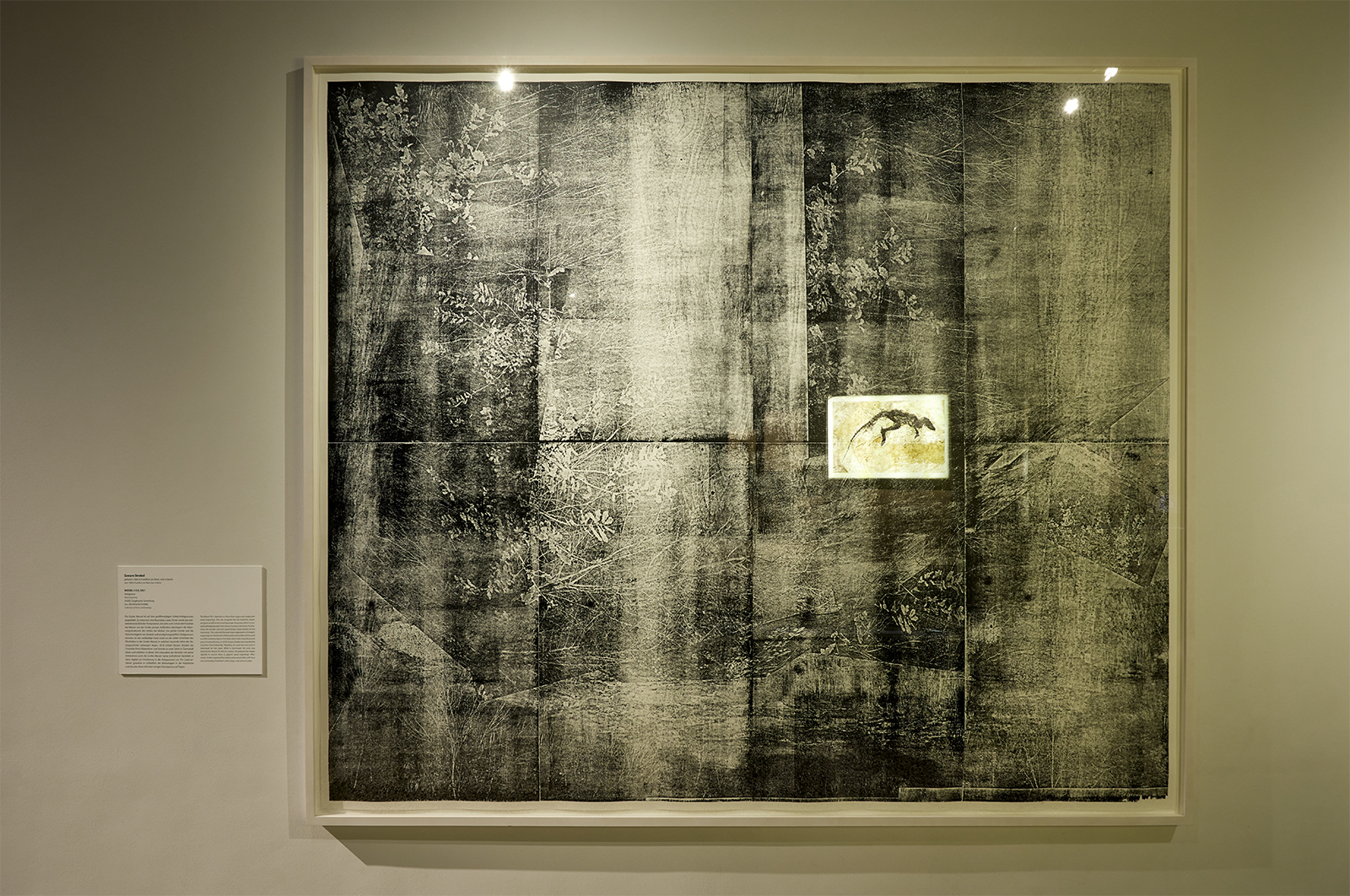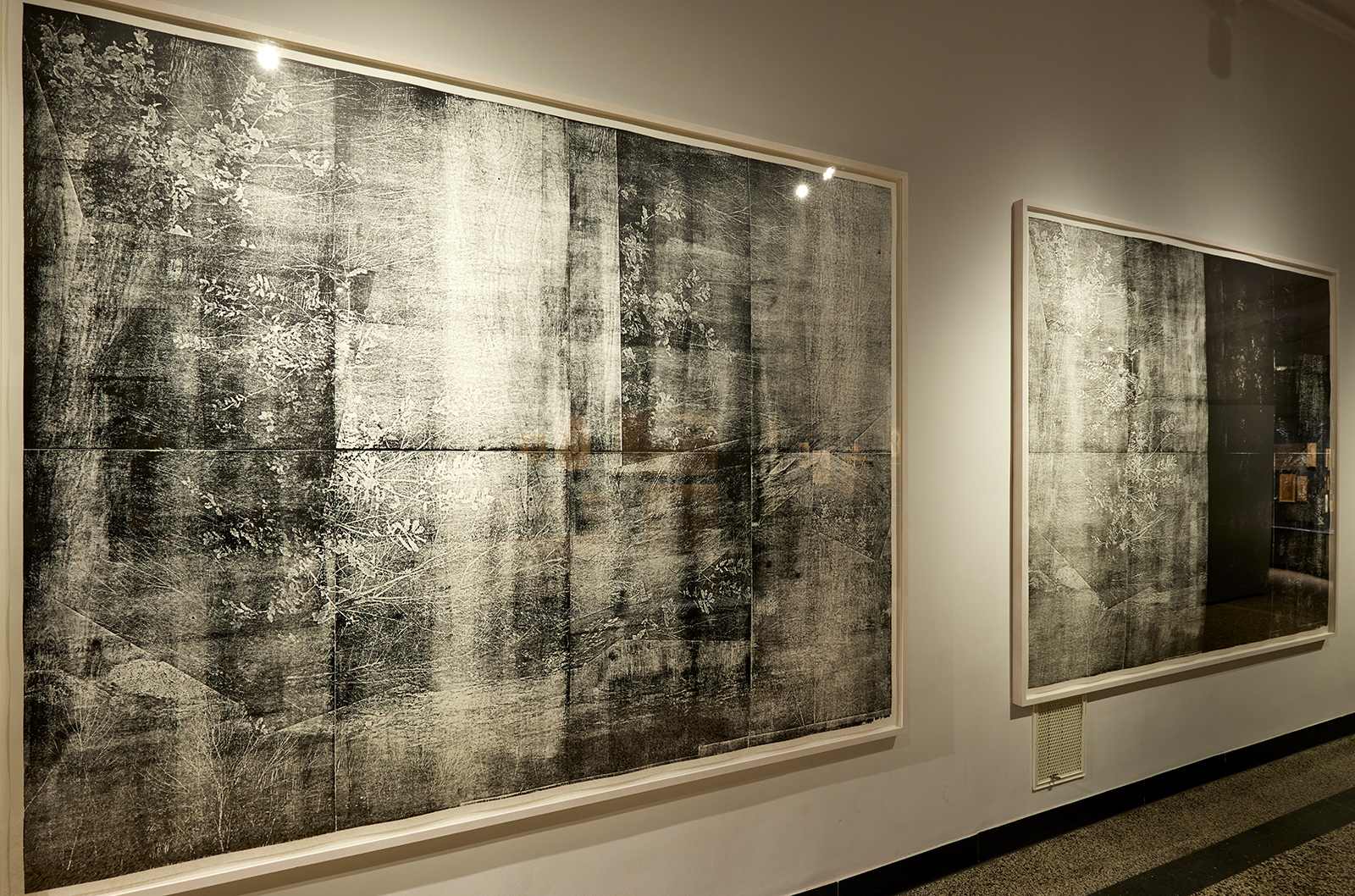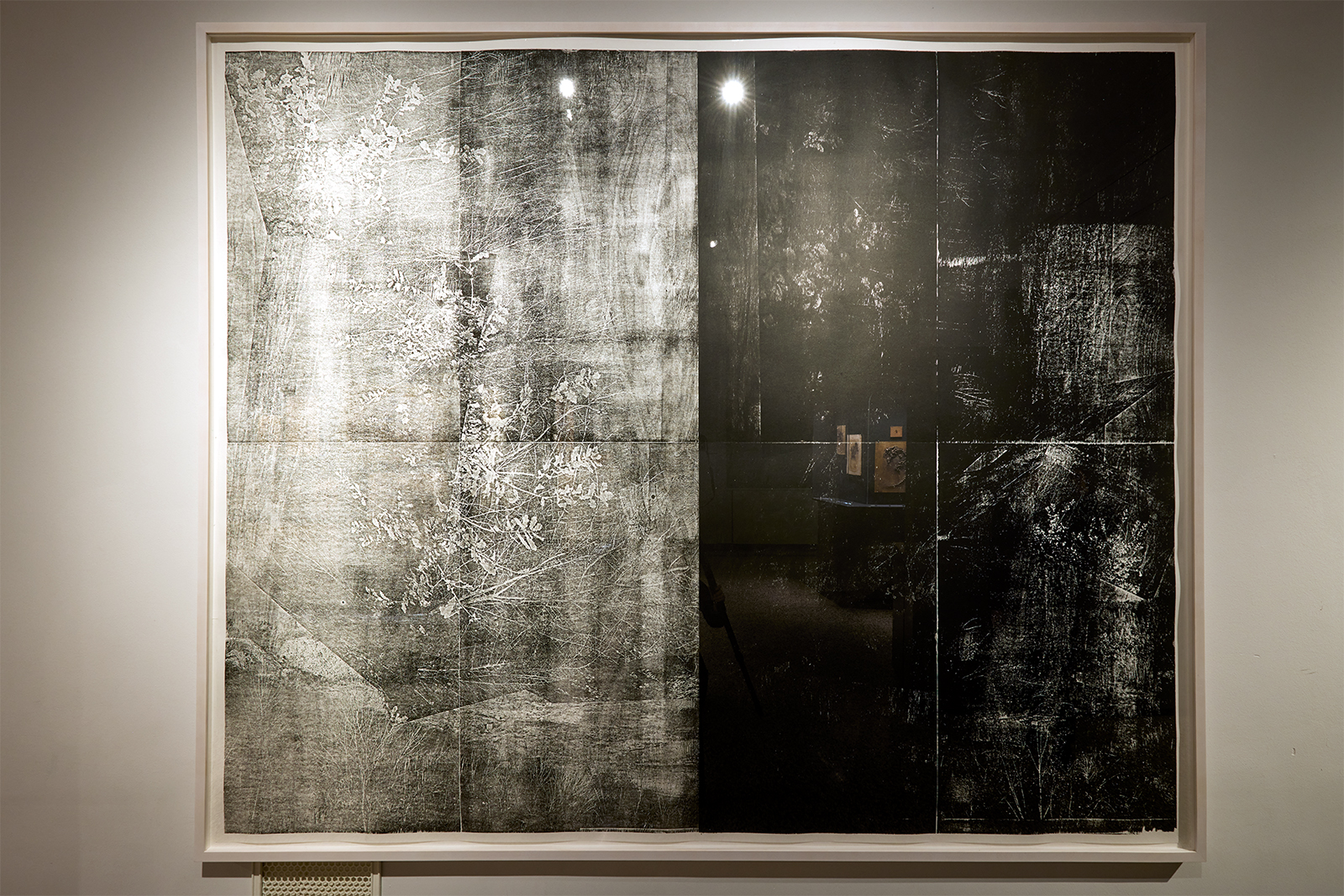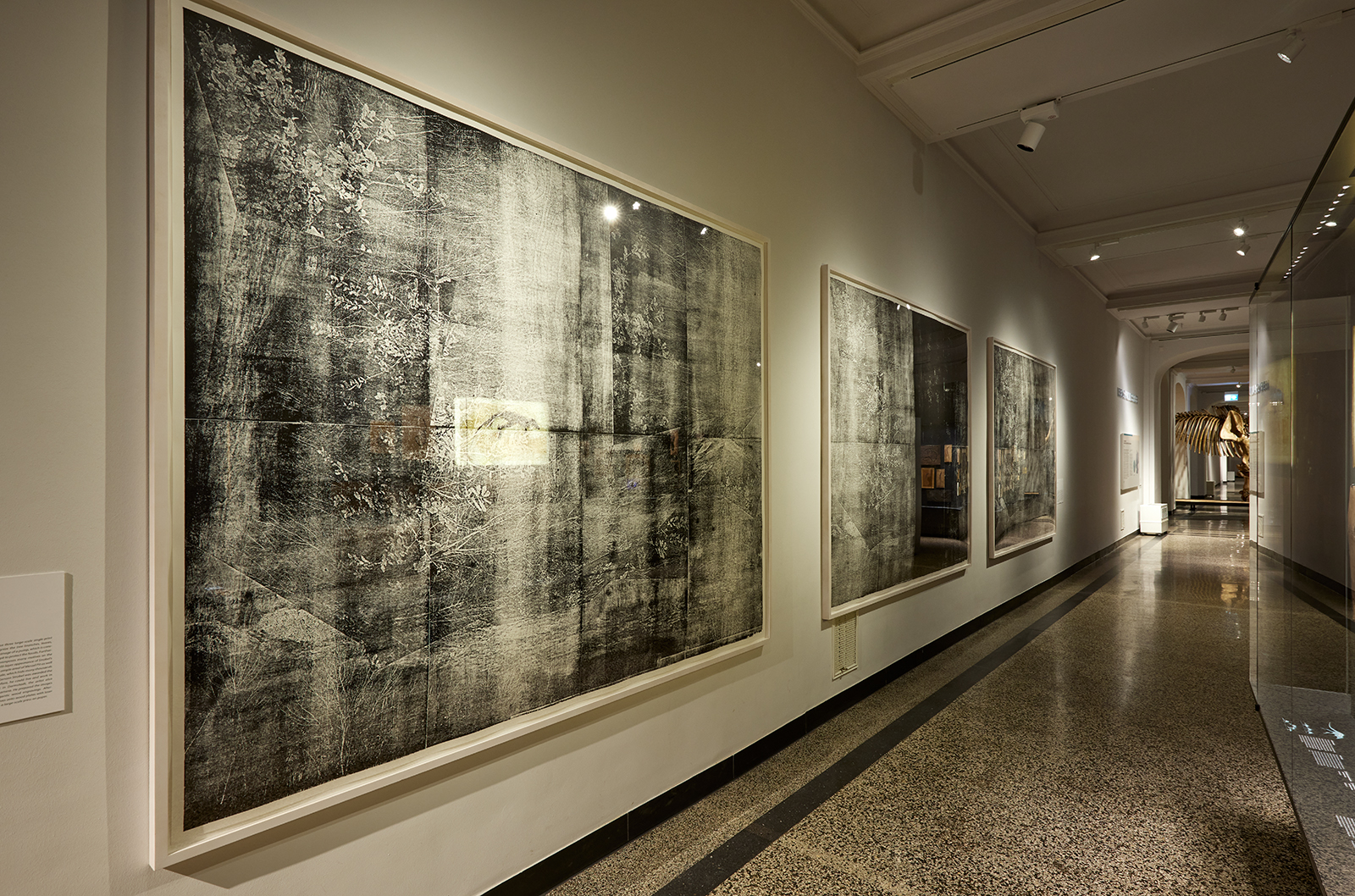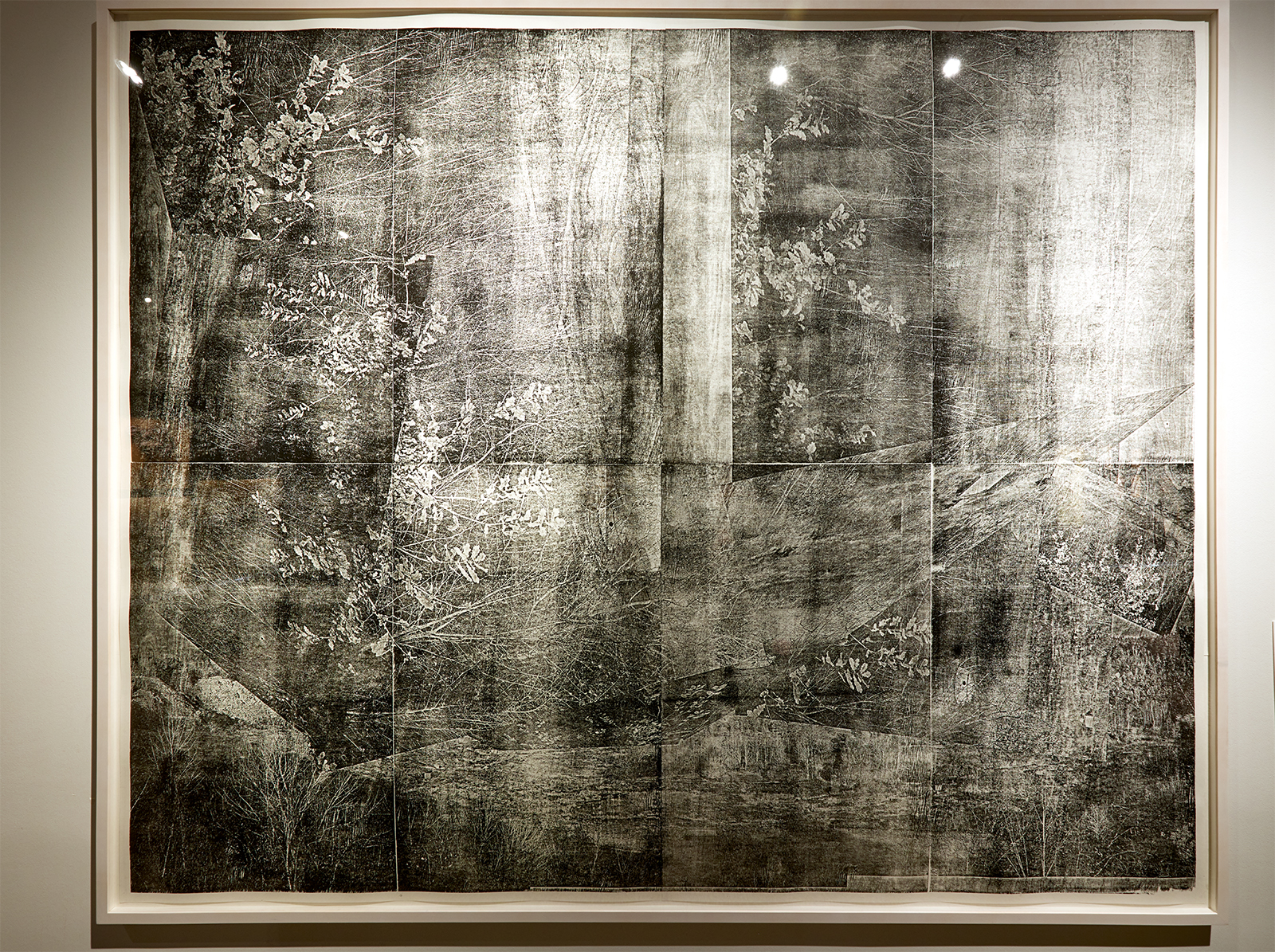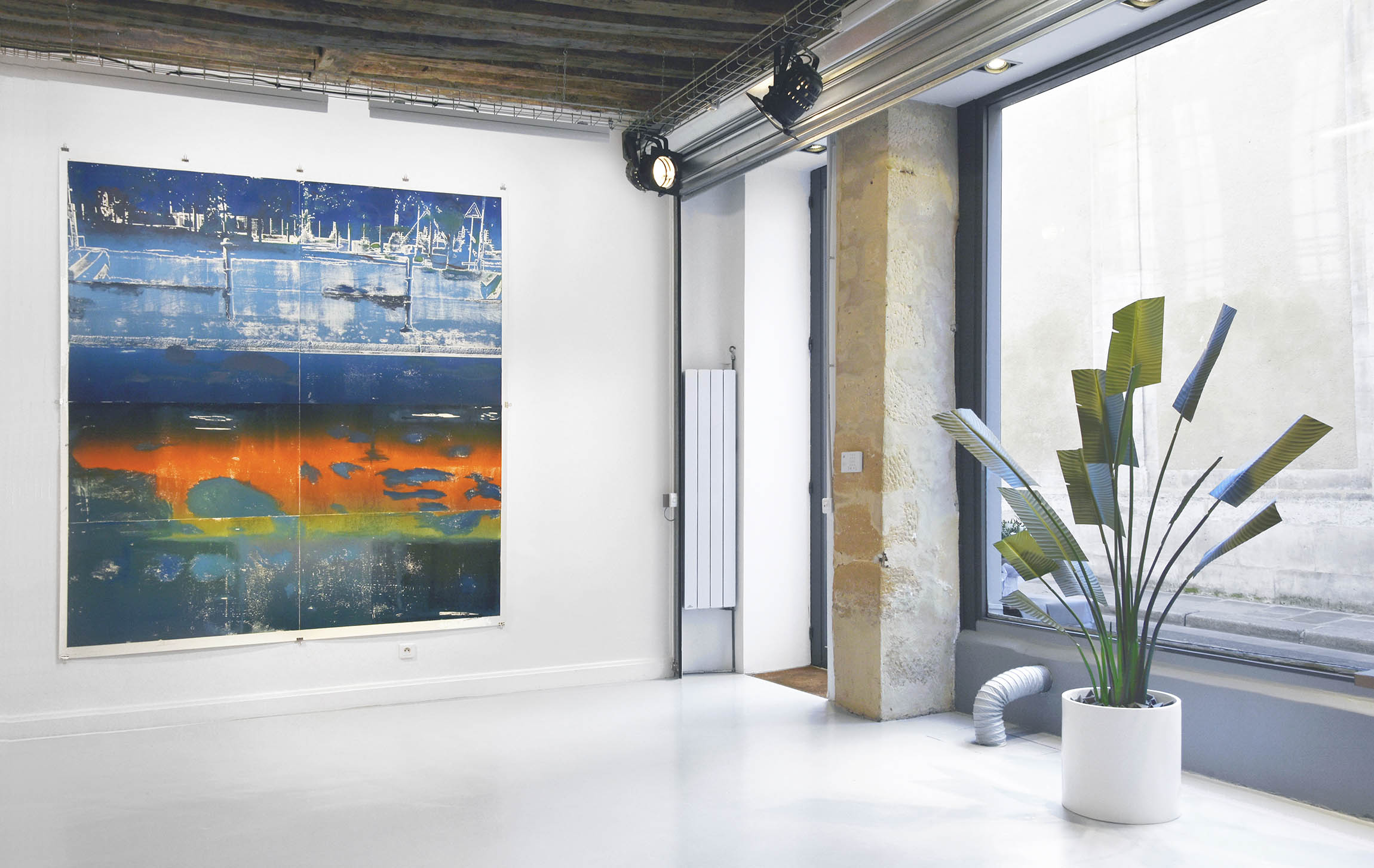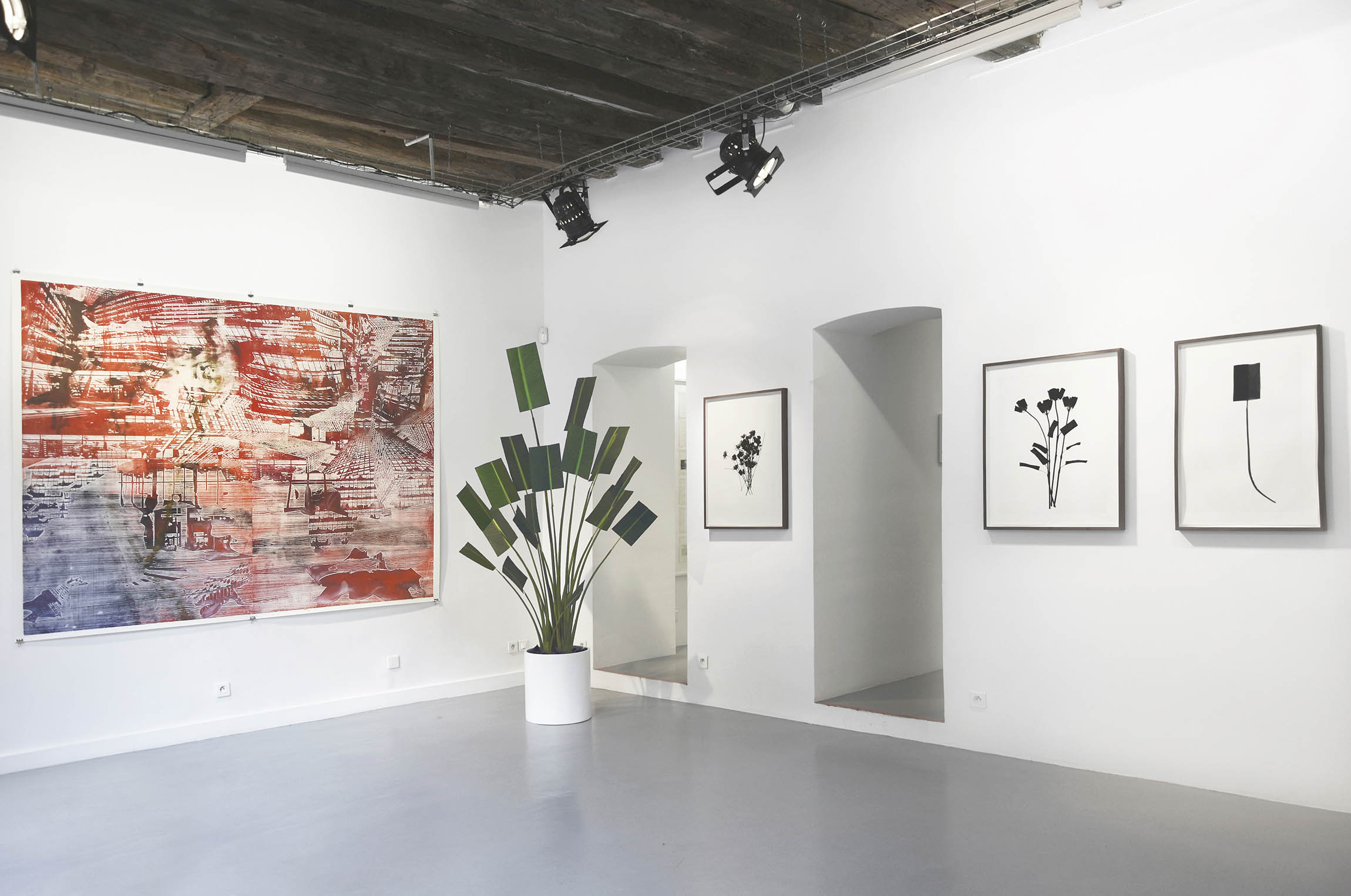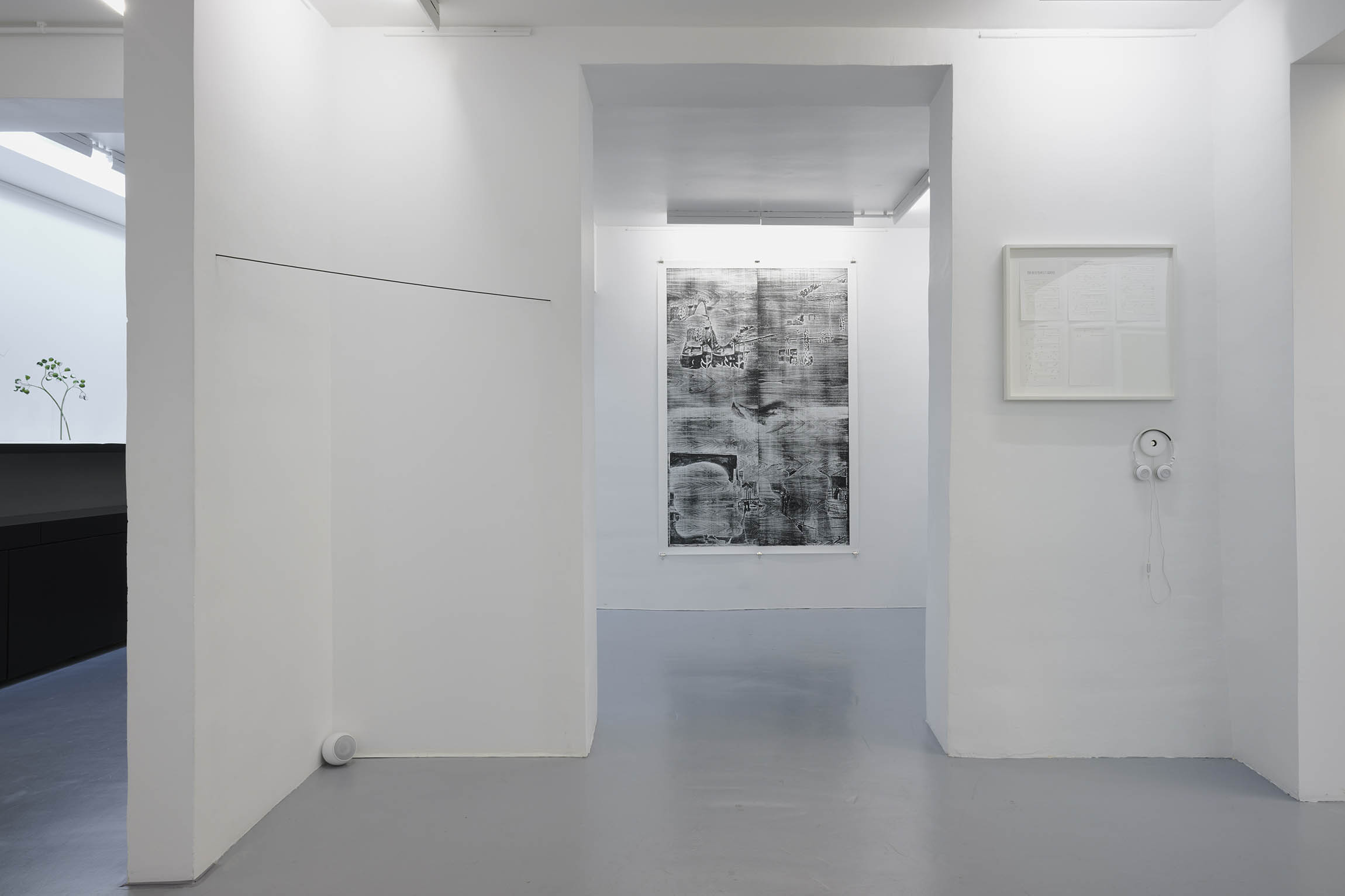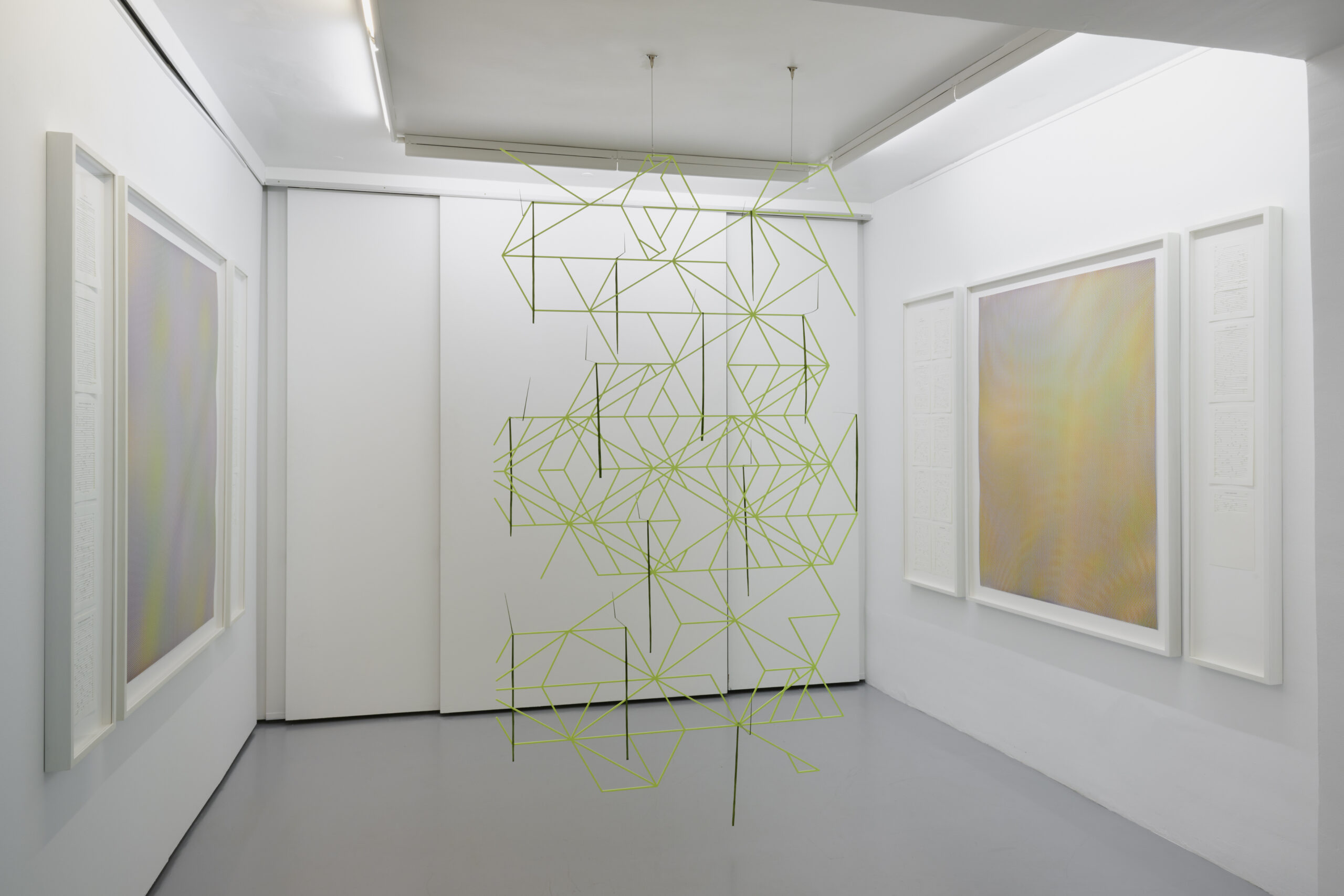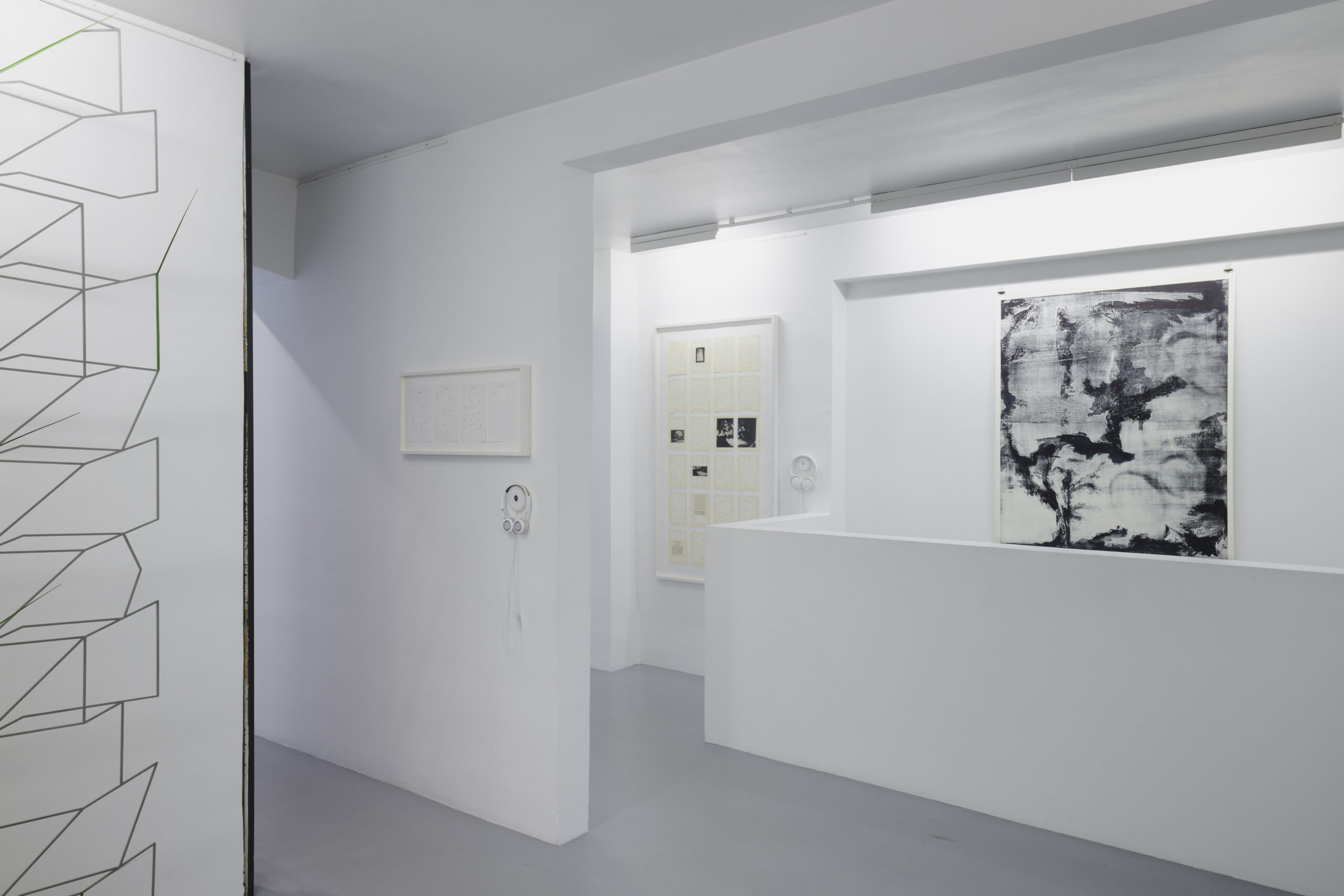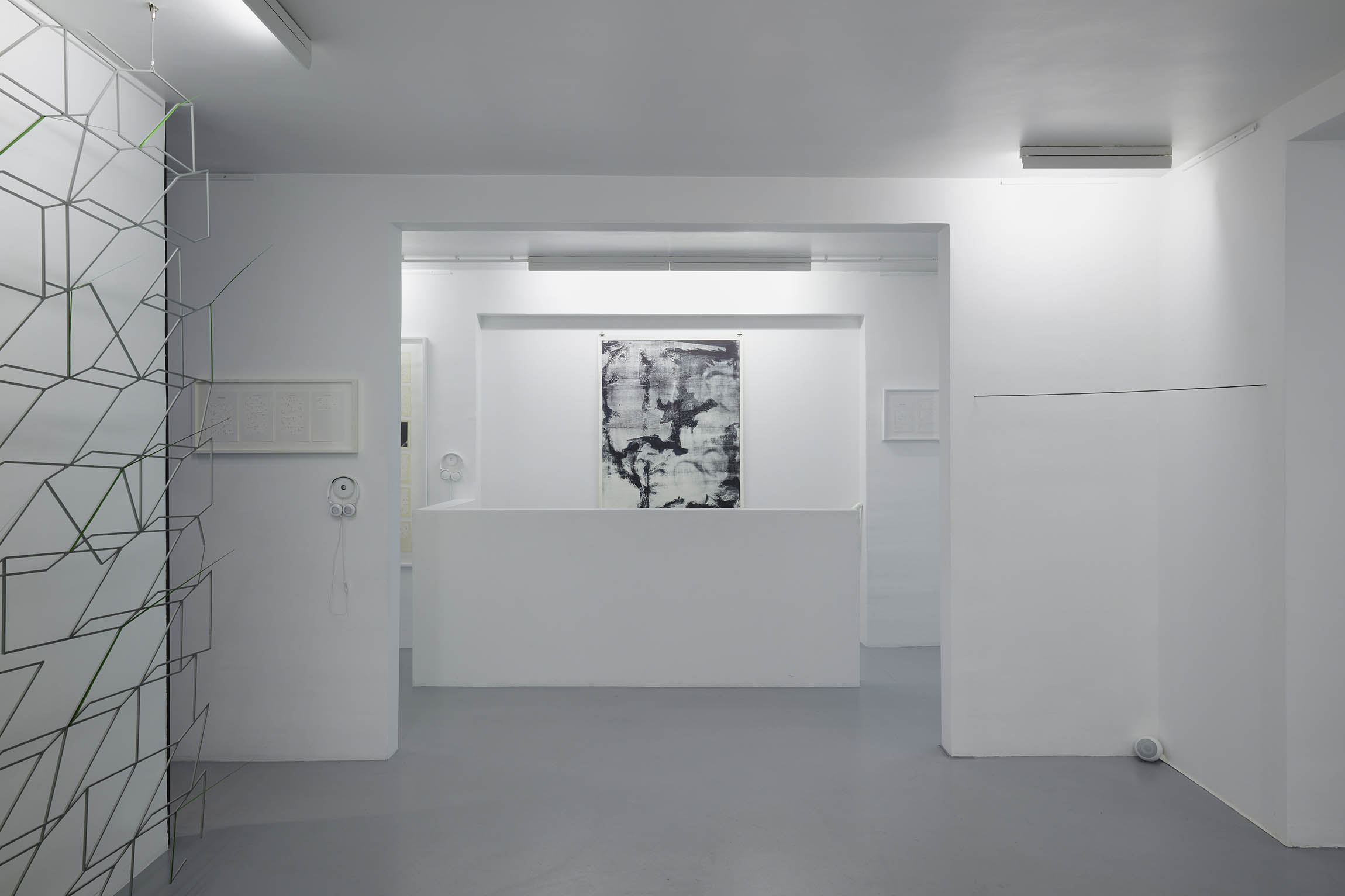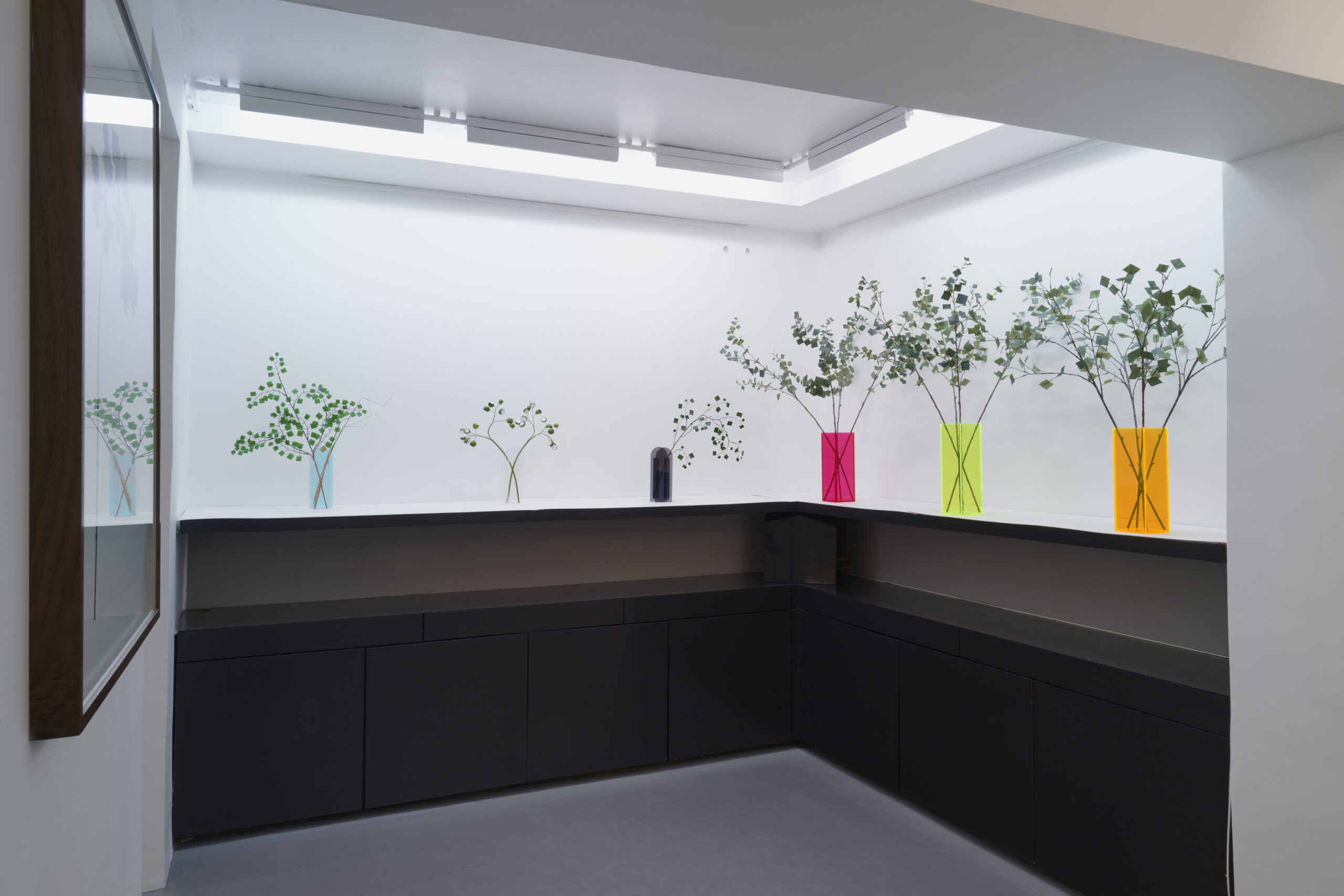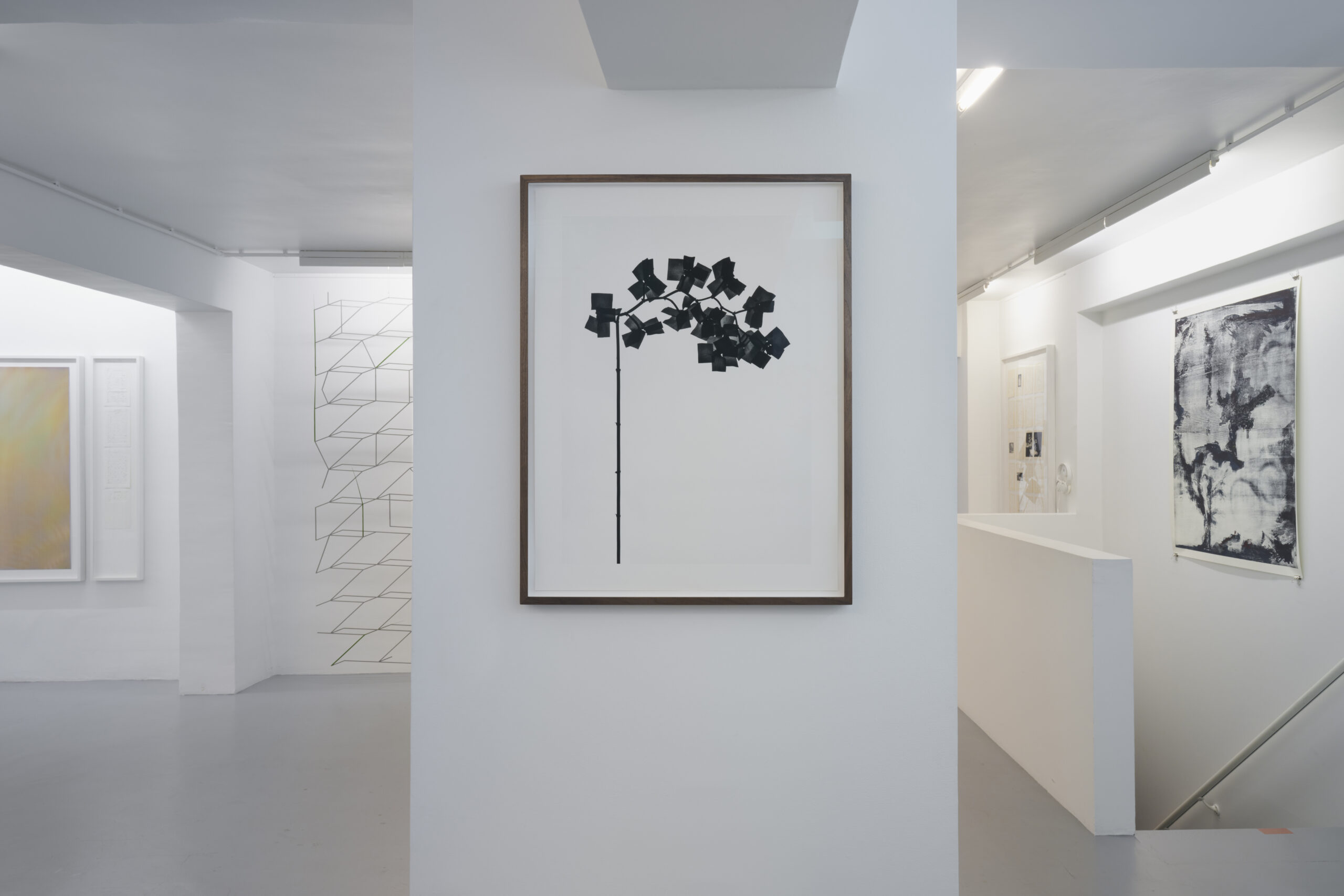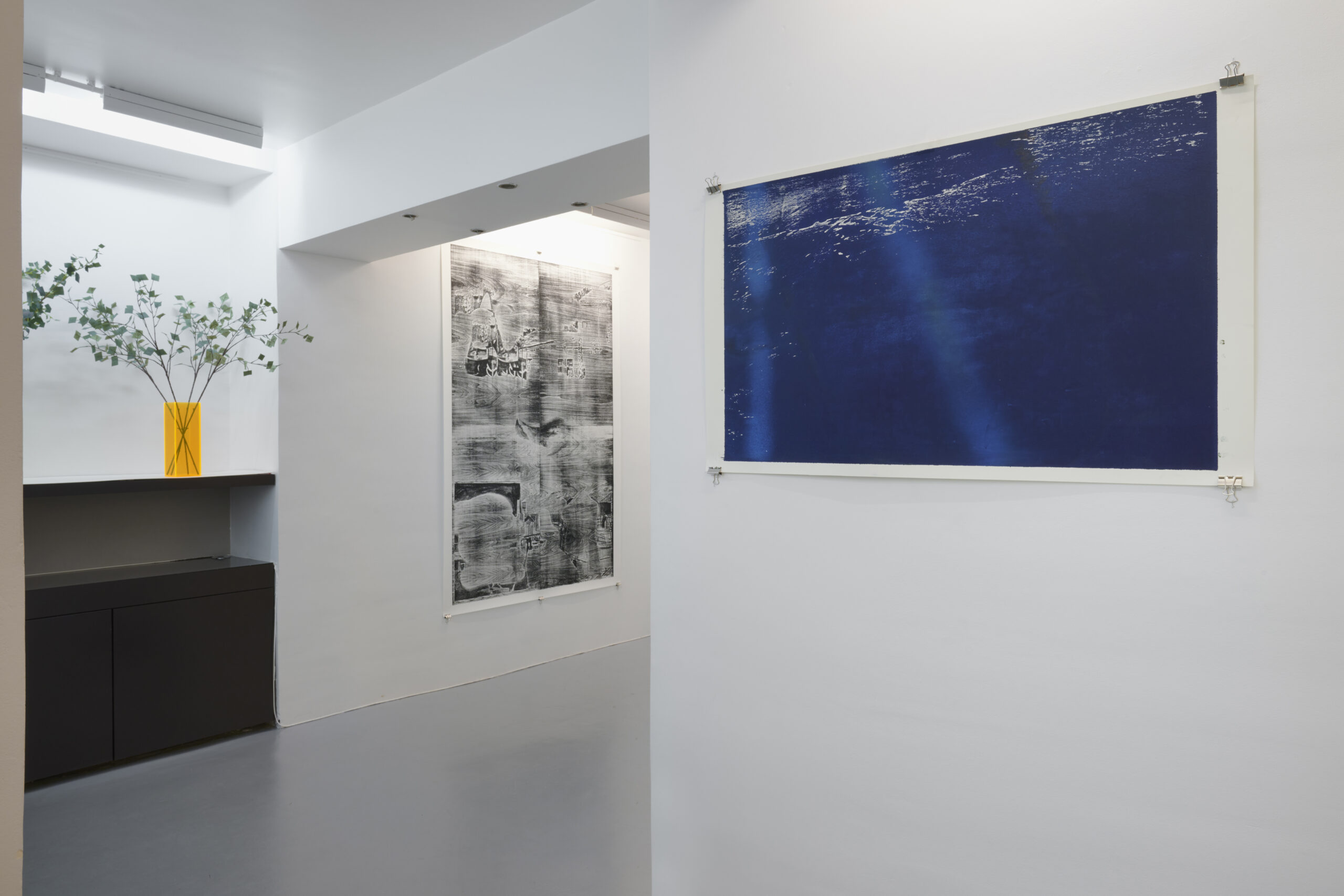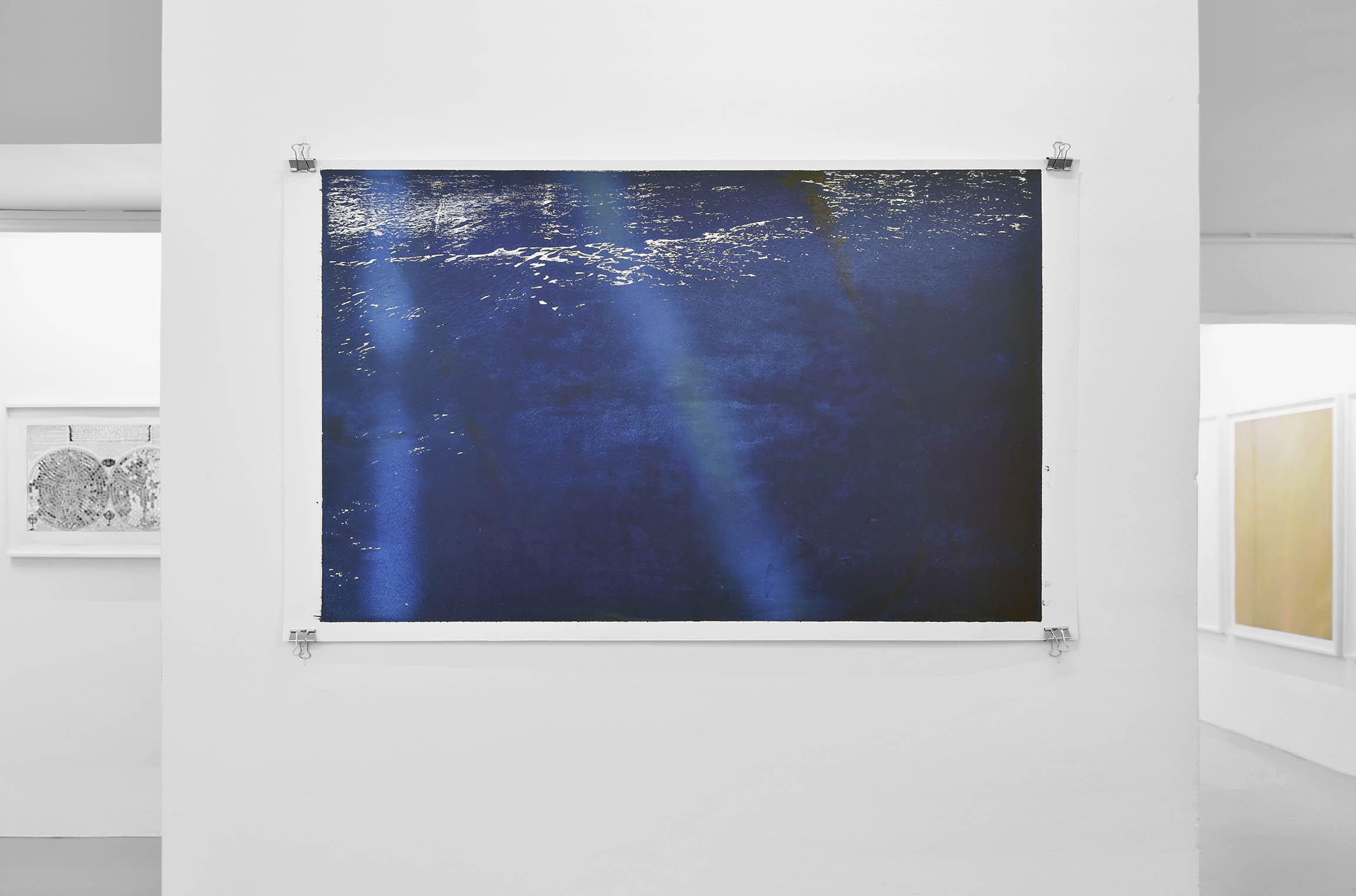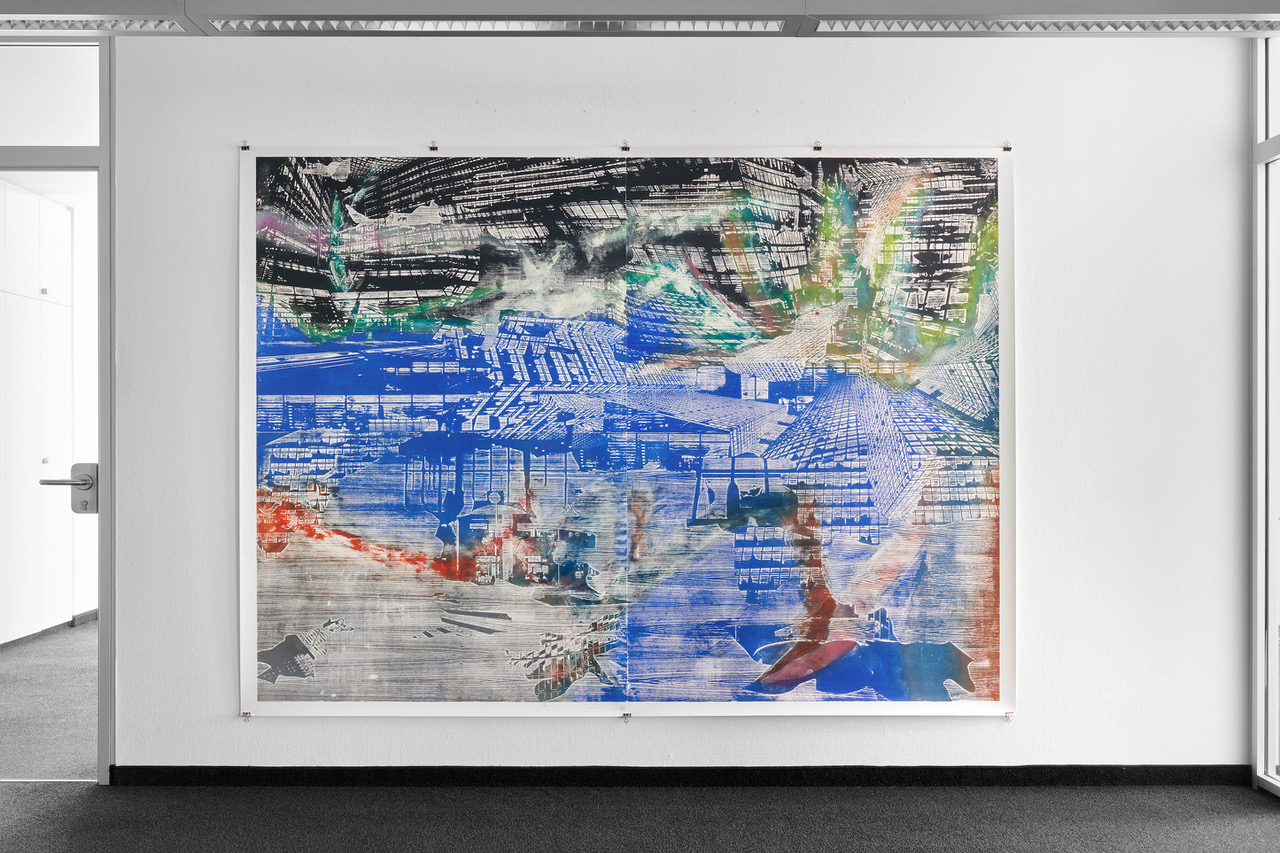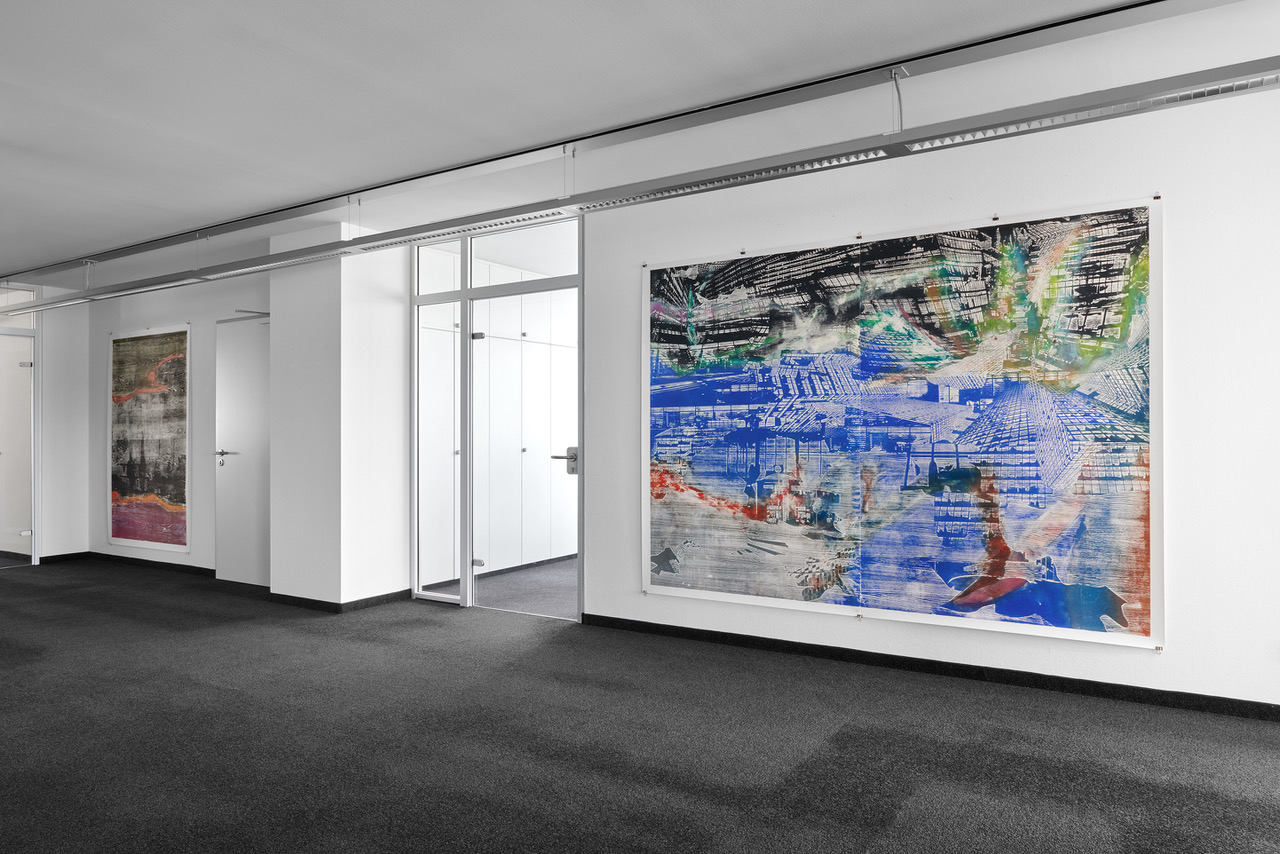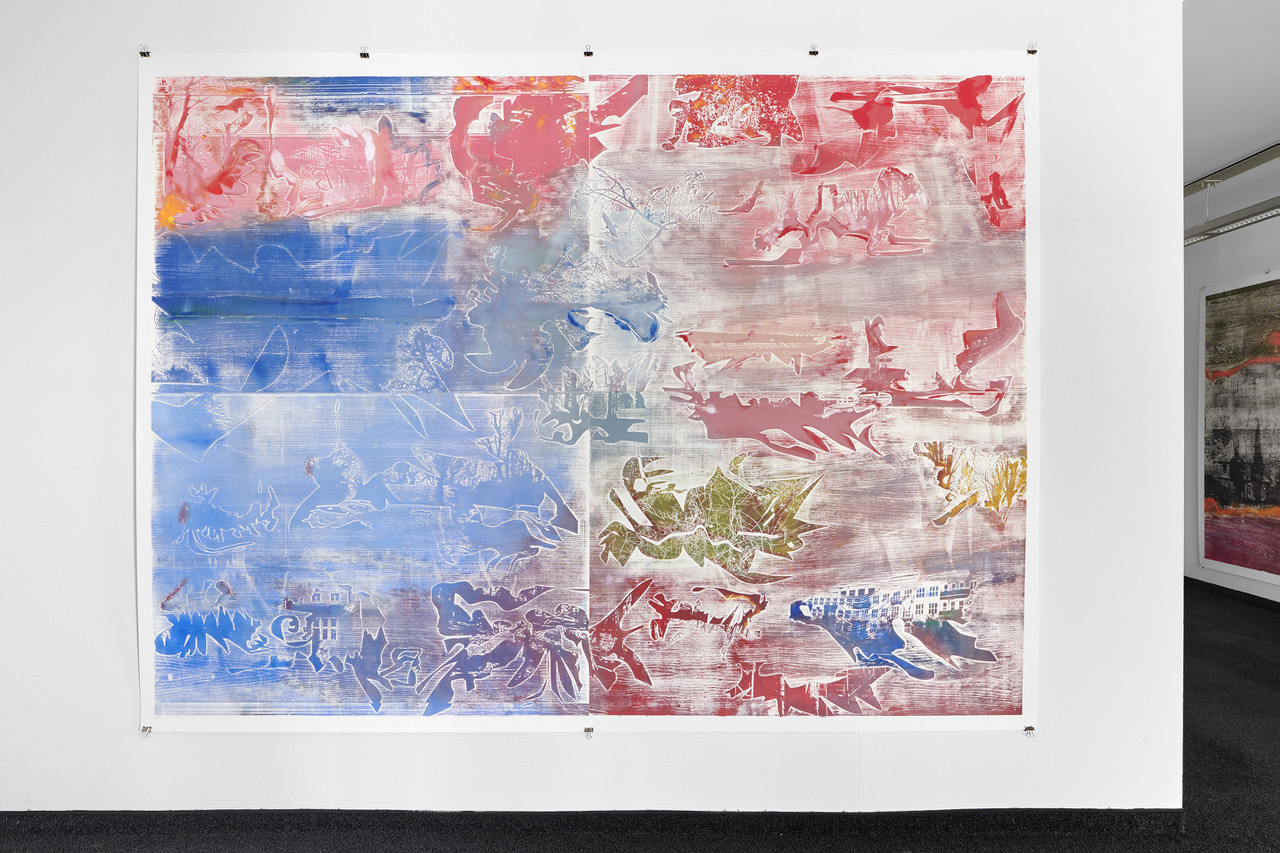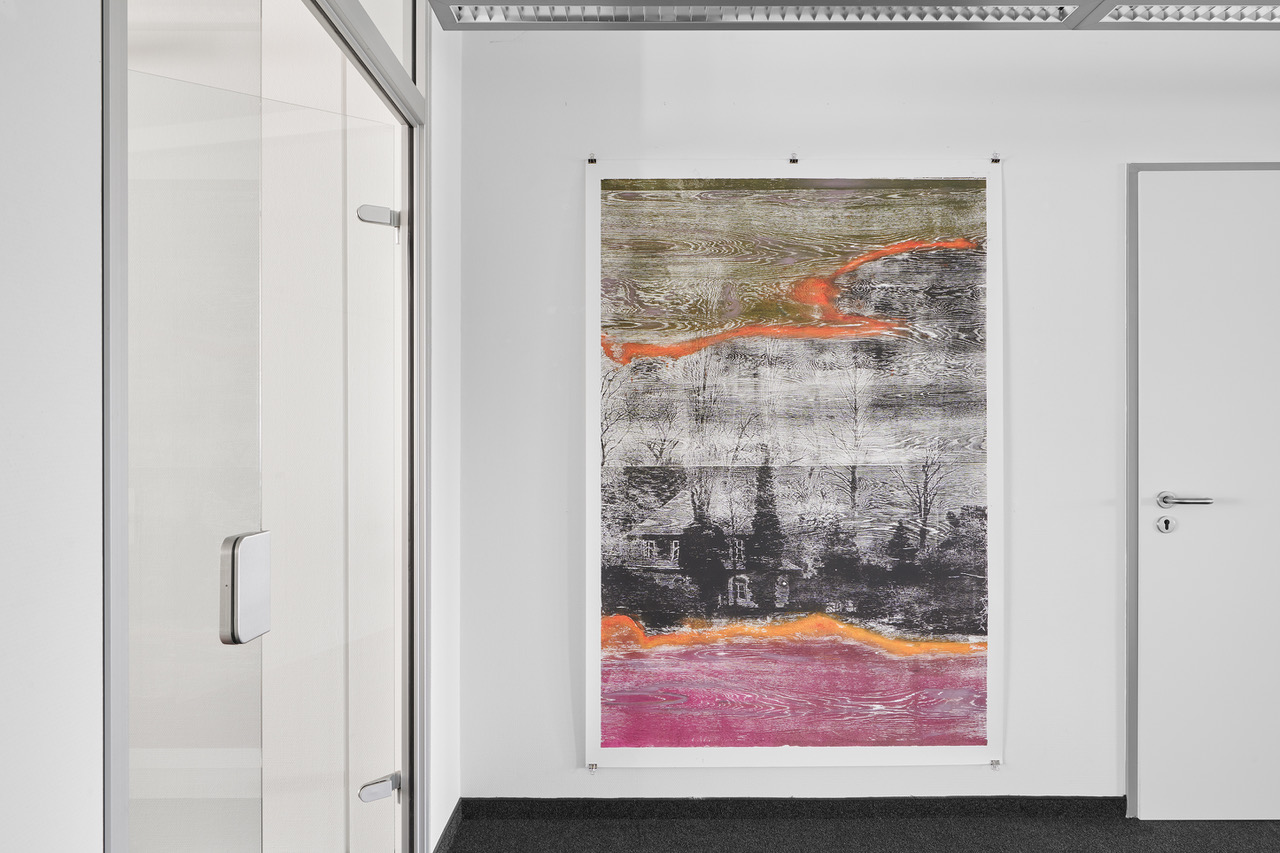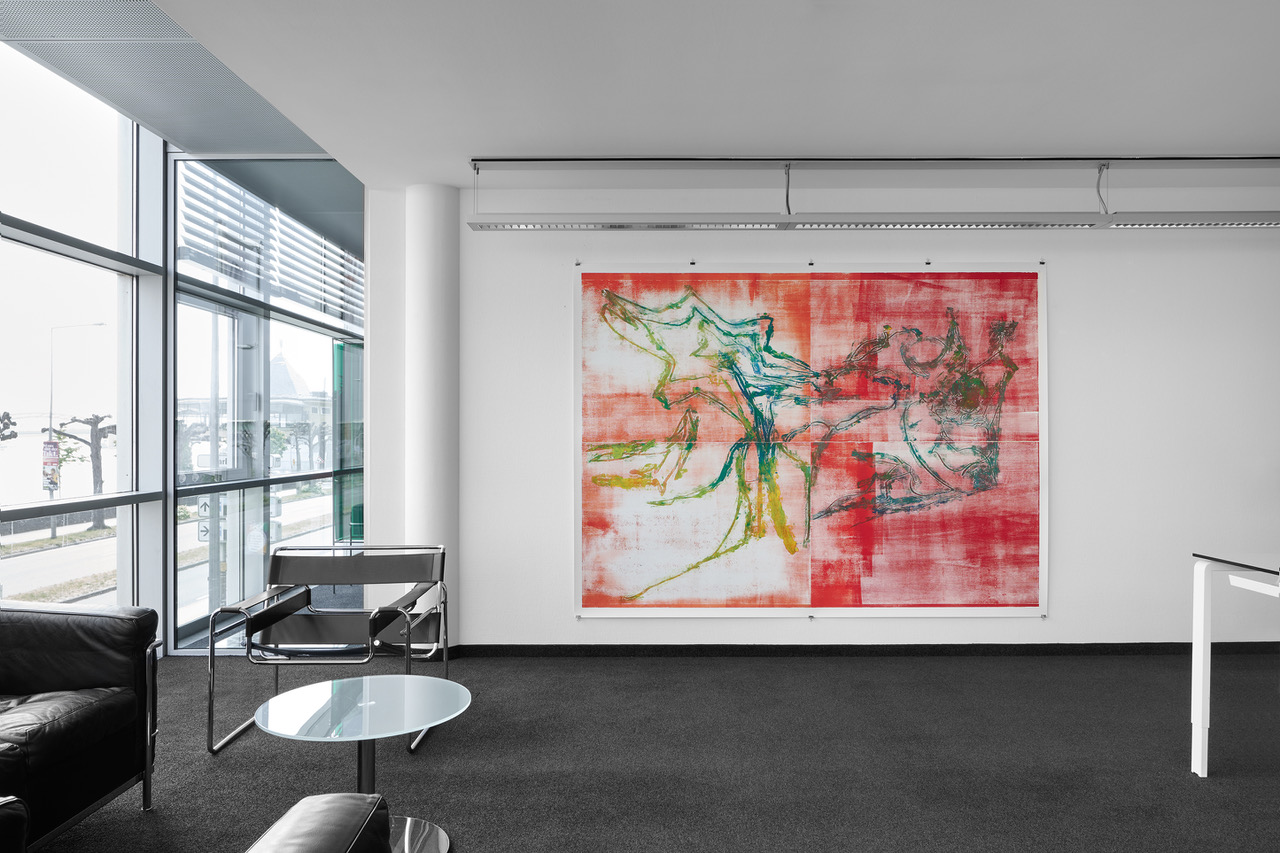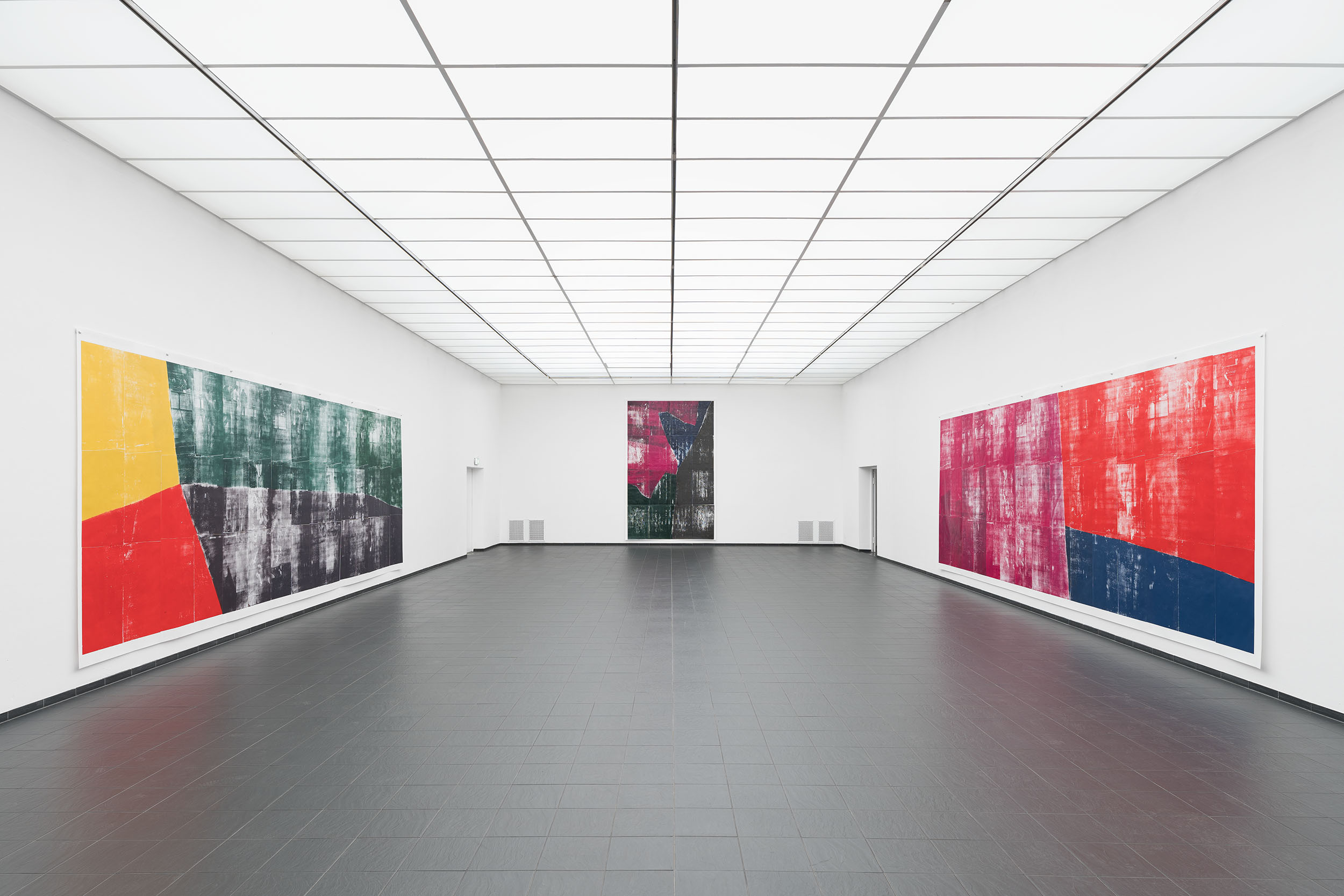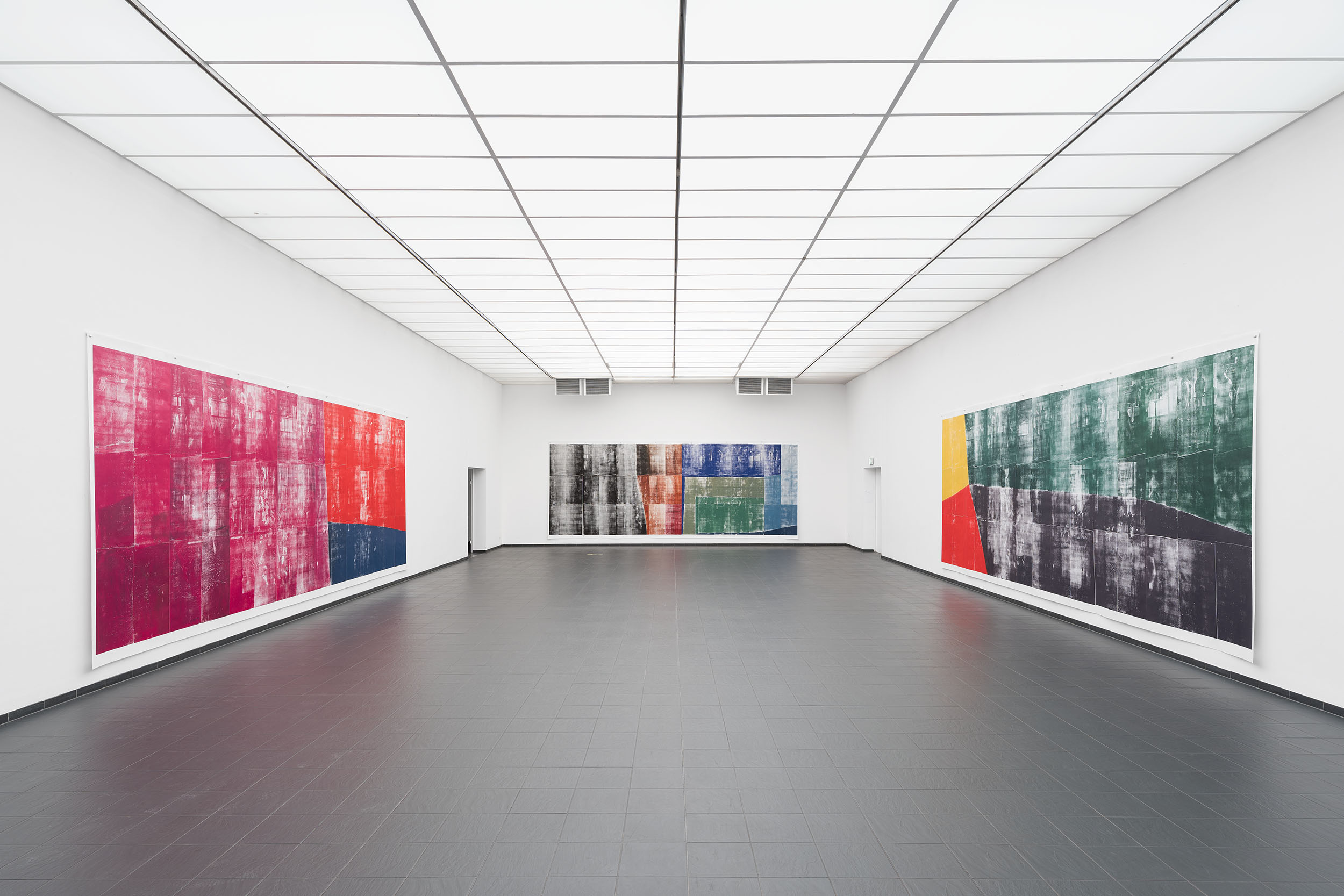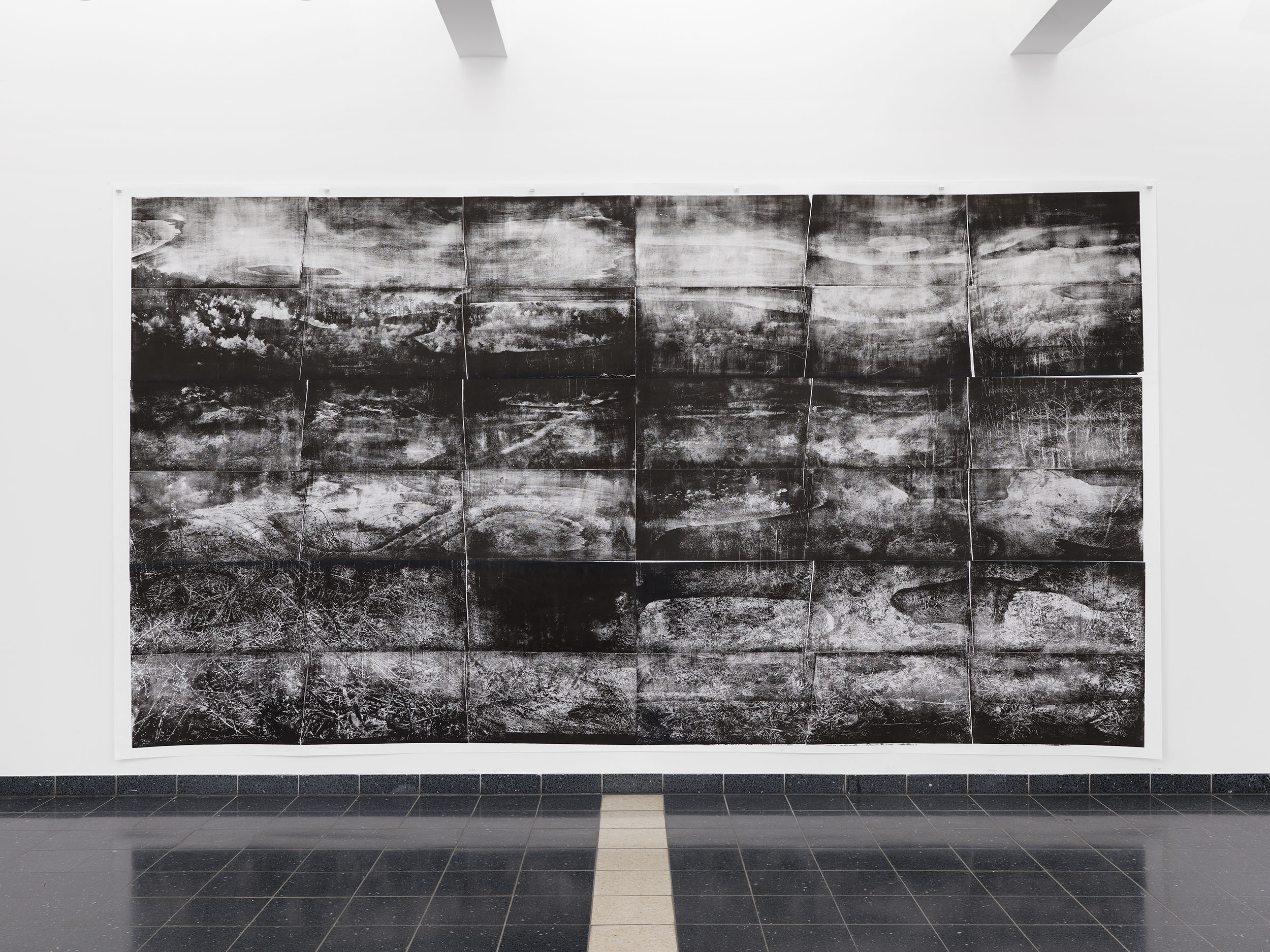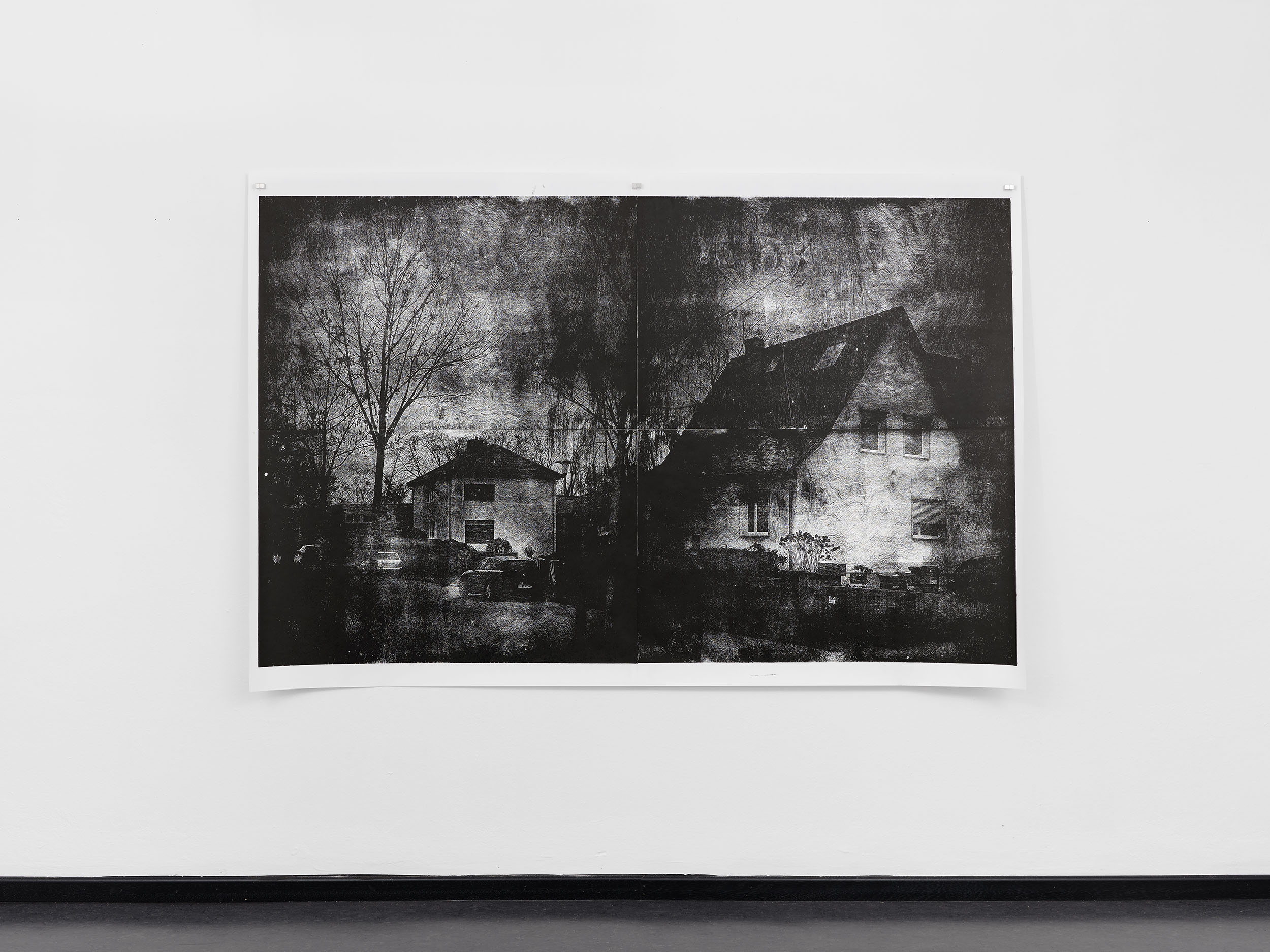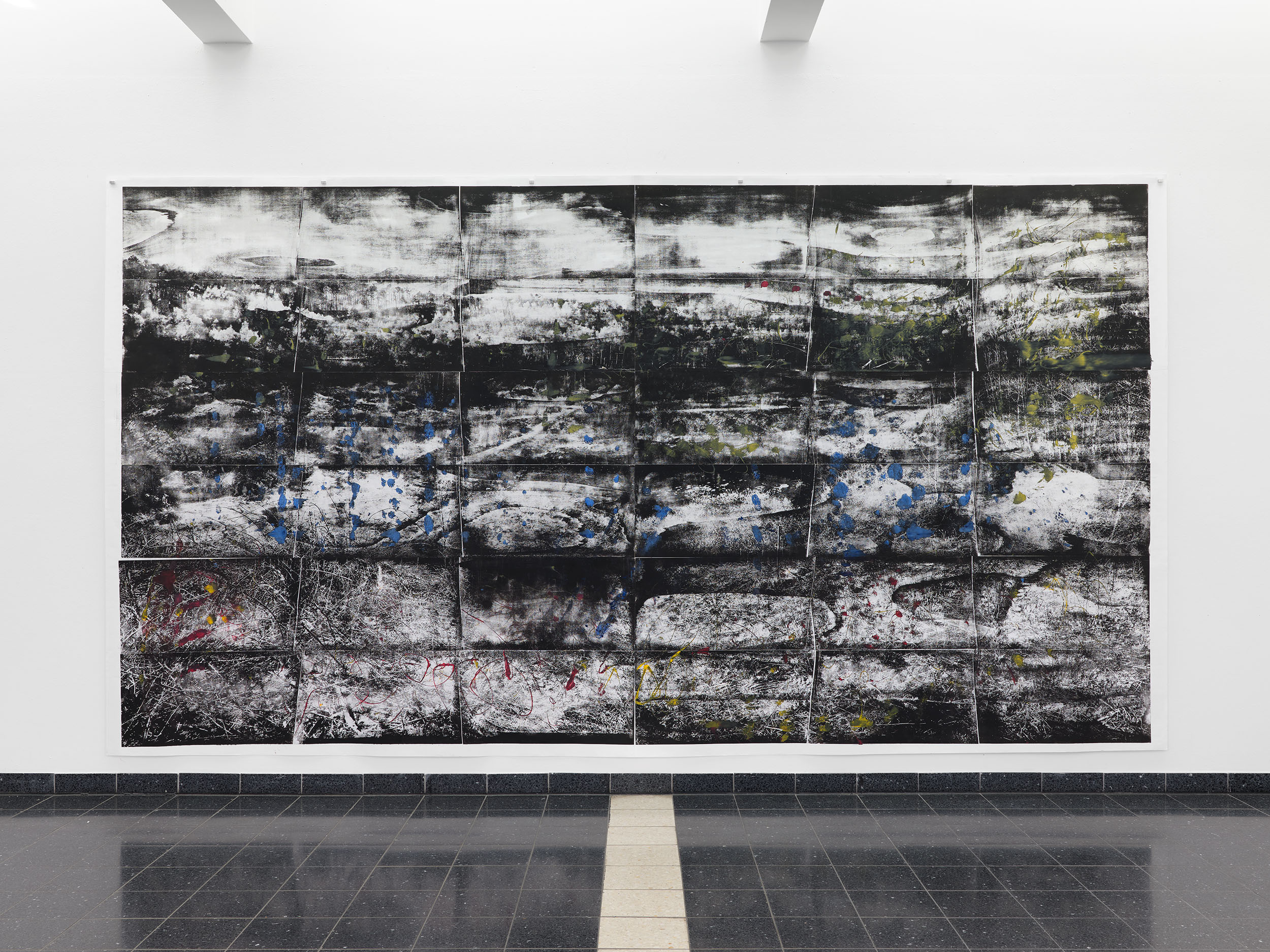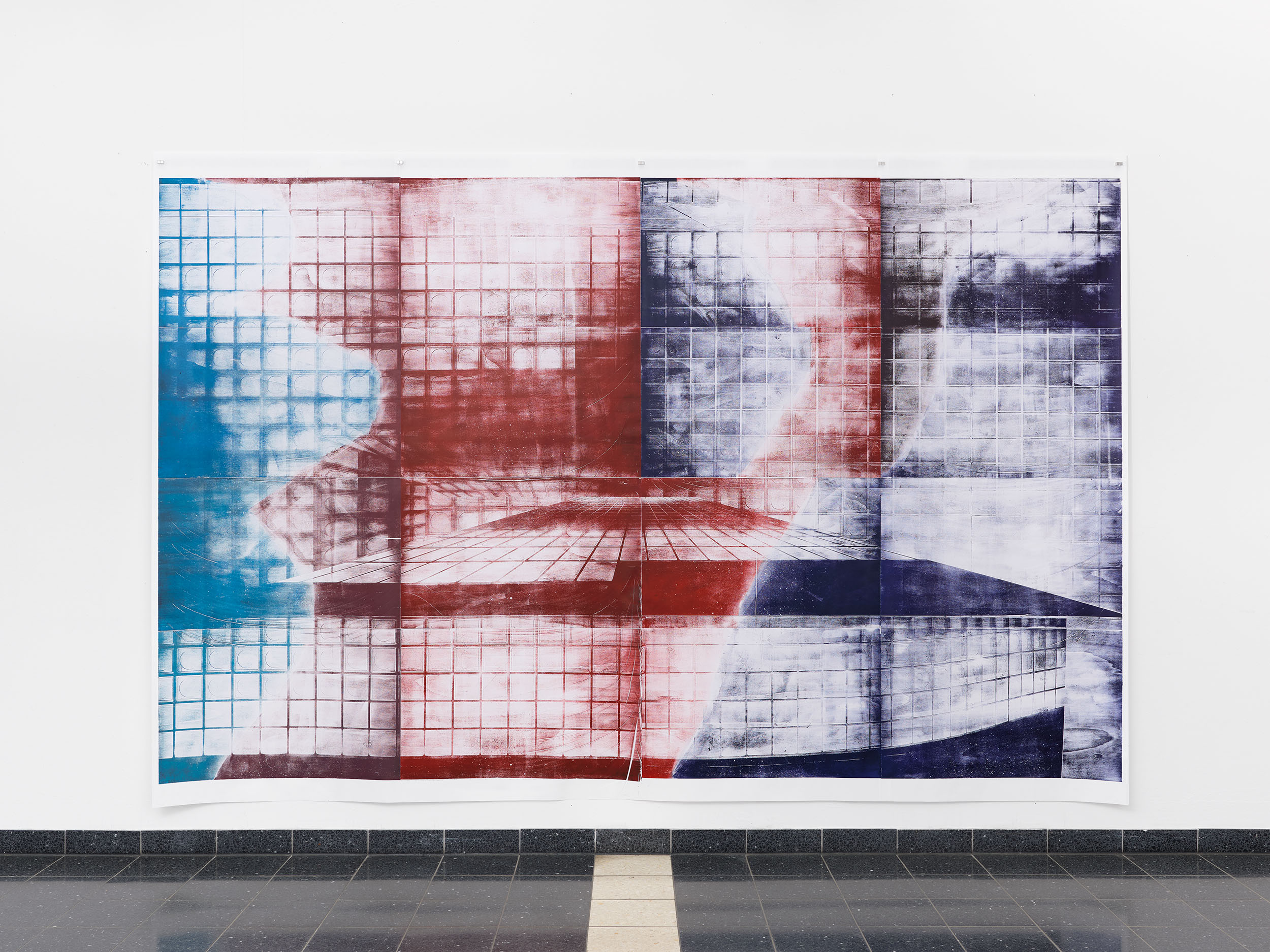MESSEL 1/2/3, 2021
Hessisches Landesmuseum Darmstadt, Collection of Prints and Drawings
Permanent Exhibition
The Messel Pit is depicted on these three large-scale single-print wood engravings. One can recognize the tree branches, leaves, and grass as well as the recurring image of a pump, which is constantly developing water from the pit to protect the fossils. Furthermore, the wooden structure superimposes many motives on the engravings. The scale and the multi-layer appearance of Strobel’s engravings are reminiscent of the ample areal of Messel Pit as well as of the numerous layers of oil shale, which hide many thousands years of natural history. In 2018, Genaro Strobel was awarded the Charlotte-Prinz-Fellowship. Therefore, he could live and work in Darmstadt for two years. While in Darmstadt, the artist also explored the Messel Pit with his camera. He prepared the images digitally to execute them as gigantic wood engravings. After words, Strobel engraved the motives onto wood plates with laser and eventually printed them with a large-scale press on paper.
Jane Benson, Genaro Strobel
Everyday to Come, Priska Pasquer Paris
January 14, 2023 – February 28, 2023
Priska Pasquer Paris is delighted to start the new year with an exhibition that brings the artists Jane Benson and Genaro Strobel into dialogue. Benson is known for her interventions into found objects, literature, and works of art, reconfiguring them into questioning reassemblies. Strobel, too, enables a new reading of the real in his wood engravings on paper using photography, painting, and collage. While his complex, contemporary narratives envision seemingly endless layers of different readings, Benson evokes a critical engagement with the current zeitgeist.
Genaro Strobel: Developing a New Image-Making Technique
Strobel’s works are monumental and rich in detail. Seen from afar, different forms emerge and different layers of narratives can be glimpsed, which nevertheless only become comprehensible from close up. The eye wanders along the distinctive lines of the wood texture that are characteristic of the artist’s work. Strobel deliberately uses the wood grain as a form defining element, integrating it as a painterly gesture.
From the traditional medium of woodcutting, Strobel has used laser technology to develop his own new image-making technique that brings together artificially conceived forms with unique natural forms by imprinting them into the grain. The work process begins with photography, which the artist understands as recording the form of his surroundings. In the studio, he further processes the image material taken with medium-format cameras either as individual photos, as collaged image compositions with artificial, digital brushstrokes, or as scanned-in pencil drawings. The printing block is then produced. The laser burns the overall motif, pixel by pixel, into the veneer wood panels Now the printing blocks are processed with brush and roller. Strobel deliberately counters the precision of photography and impression with gestural traces that he paints on the printing plate with a brush. Other areas of the imprint allow large fields of color to dominate the image motif and envelop the sharp photographs in a mist of color. Within this process, the artist paints in mirror image and applies the paint in a sequence of fixed layers, as at the moment of impression the paint mixes and glazes from back to front. The final step in creating the work is when Strobel applies pressure to the painted wooden blocks to transfer the oil paint onto the paper in mirror image. After that, the paintings are not further processed, but rather deliberately left alone to preserve the thin, homogeneous layer of paint.
Changing Perspectives through Multi-Layered Narratives
Strobel often works in series of images that extend hermetically and numbered over several printing blocks. Nevertheless, each image also stands for itself, as it reveals its own perspectives and points of view. In his series of color circles, of which there are 15 so far, Strobel refers in the titles to the well-known representations of color circles, but they are paintings that each embody their own color laws and systems. In Farbkreis 14, a horizon line seems to divide the painting into two parts, and a cityscape emerges above the abstract color play. It is an impression of Ella Trebe Street, which the artist captured with a medium format camera. Segel 2 also transports the viewer to Berlin, the print block made of Albasia wood is based on medium format photographs taken in the area of the Nuthegraben. In the studio, the artist further processed the images by collaging cut-out shapes from them and supplementing them with digital painting. At first, the picture appears completely abstract, with formations that verge on threatening, reminiscent of clouds of smoke. Only on closer inspection do the individual elements of the picture seem to emerge. Then, too, the dark surfaces reveal themselves as multi-layered combinations of different colors.
Jane Benson: Methods of Destruction as Strategies of Regeneration
This deliberate play with the viewer, in which Strobel demands a close look, also comes to bear in the multifaceted work of Jane Benson. The artist’s multidisciplinary approach spans the mediums of sculpture, sound, digital media, and prints. The works in Everyday to Come see Benson cutting and fracturing fake plants and books only to reassemble them through her investigative practice. Methods of destruction are used specifically as strategies of regeneration – opportunities to reassemble, redesign, and reinvent existing entities. In her Faux Faux series, the artist explores a prevalent illusionist trend: artificial plants are, unfortunately, in vogue. Today, copies decorate living spaces appearing deceptively, persistently real. Nature is not represented, but imitated, whereby reality and fiction merge in such a way that they become indistinguishable.
Benson cancels this unification of reality and simulation that the artificial flora suggests by cutting the leaves into geometric, unnatural shapes, such as, triangles and squares. Indeed, cutting reduces the artificial plant to fragments of itself, severing it from the familiar to embrace a new interpretation or future reality for the fake. The process of transformation is made visible and gives the mass-produced flora its own individuality; no element is congruent anymore, creating a more “authentic” rendering of illusory nature by the artist. Benson’s hanging Flat Planter works are an extension of this work into an architectural scale, and a wry comment on the garden wall that has come to represent eco-architecture.
A series of black and white prints complement Benson’s sculpture. The photographs document the silhouettes of the unabashedly fake flora. The images are reminiscent of photograms, which were created out of a desire for an economical, true-to-life image. Unlike photography, however, a photogram does not involve a camera, light-sensitive paper is exposed directly causing the uncovered areas of the paper to darken, thus, each image is unique. In mimicking the photogram, Benson’s photographs once again reinforce the game of masquerade and show that the perceptibility of the real is accompanied by a multitude of simulated gestures.
Rewriting Narratives through Music
In dialogue with Benson’s Faux Faux works are a series of text and sound works. The End of the Patriarchal System and A Moral Renaissance are investigations into the contemporary resonances of essays by British suffragette Mona Caird. Benson dismantles and reconstructs the literary works by excising syllables of the musical scale— do, re, mi, fa, soh, la, ti —to reveal a found score. In a further step, Benson translates the excavated scores into geometric color field prints based on Isaac Newton’s similarly arbitrary Color Spectrum. Layers of dots in various hues create a delicate moiré effect that visually embodies the revolutionary texts. The scores and abstractions invite the viewer to join in the act of translation at a time when it is essential to re-write and re-imagine women’s rights.
Against the Spectacle
Side-stepping the cynical, Benson emphasizes the absurdity of the false green, and classical forms of categorization, prodding us to look anew at culturally accepted objects and ideas. Benson makes the artificial plant what it is: a new creation of reality. Genaro Strobel also evokes a narrative space for possible critical perspectives by expanding the biographical perspective to include a worldly one: “Think so far beyond the planet, the solar system, the galaxy, the universe, until life itself becomes strange.” (Genaro Strobel, 2009) Today, within the current socio-political context, where the fake (news) challenges the real and falsehoods challenge truths, the need to question everything is paramount. Everyday to Come brings together work that refuses the spectacle.
Dr. Wiebke Hahn
Genaro Strobel
Shining Bright, Priska Pasquer Gallery, Cologne
April 30, 2022 – July 15, 2022
Genaro Strobel’s exhibition “Shining Bright” features a selection of four medium-sized wood engravings produced in Berlin and Vienna in early 2022 along with a previous one from 2018. Strobel first presented four of his “Farbkreise” (“Color Wheels”) at his exhibition “Size” held at Kunsthalle Darmstadt in 2021. Measuring 4 meters tall and 7 meters wide, they easily filled the main hall there. Displayed in an informal setting overlooking the Rhine (the Priska Pasquer Gallery’s temporary home in Cologne), their theme takes center stage. In a nutshell, color is Genaro Strobel’s theme. Instead of the photogravure and letterpress inks he’s previously experimented with, this marks a return to artists’ oil paints, no doubt because of their unsurpassed radiance and their spectrum – and also perhaps because he’s seeking to get closer to painting.
Genaro Strobel has continuously developed his technique referred to here as “wood engraving.” He begins the process by familiarizing himself with a place, observing and returning to it. Having conceived of a picture, he then starts taking more specific photographs. Once he’s decided on its format, he uses graphics software to continue editing his images before cutting – or rather burning – entire images onto a series of wood veneer panels with a laser. He then applies ink to these printing blocks with brush and roller. The resulting prints are merely assembled; no brushstrokes are added, no corrections made. Each of Strobel’s works is unique, for the combination of photographic image, impression (grain), and expressive painting always gives rise to a new work that’s more than the sum of the sequence of interrelated steps in its creation.
When taking a walk through the forest, we see each tree as an individual. And its individual fate is probably what Genaro Strobel has in mind by highlighting the grains of various tree species (e.g., ash, cherry, poplar, and walnut). Apart from the grain, however, the veneers – cut and mirrored – come into their own in the exhibition. The veneer prints are presented horizontally, i.e., the trunk has been tilted by 90 degrees. As a result, the background somewhat resembles the surface of a river flowing calmly.
“Shining Bright,” the piece lending its title to the exhibition, yet also “Farbiges Grau” (“Colorful Gray”) leading up to it, are both characterized by figures. Some round, others outlined, they stand out from the background by means of a halo, whose color they can adopt like a chameleon. While talking to Strobel, he explained that the bizarre figures represent memories of walking through Berlin and that, just like visitors to a city or an art gallery, they, too, can now immerse themselves in something – namely the imprints of veneer patterns!
In his compositions, Genaro Strobel allows color free rein. Refusing to systematize it, nevertheless he confidently associates his “Color Wheels” with attempts by, say, Goethe to describe the wavelengths of visible light as accurately as possible. His “Color Wheel 11” in orange and red selected for “Shining Bright” is superimposed with the greatly enlarged motif of a line drawing (also by Strobel) which, with its yellow and greenish-blue coloring, is reminiscent of a coat of arms on a flag. “Schwarz” (“Black”) is the title of the last of his new works. This, the darkest of all colors, has always exerted an effect on viewers that’s hard to describe. Genaro Strobel tries to capture this impact as something “draining” in an image where the color black is deep and, thanks to its warm color gradients exemplified in this work, emphasized as the main motif.
The earlier work from 2018 bears an abbreviation as its title that stands for “Zwischen dem Auge und dem Gehirn” (“Between eye and brain”). Printed entirely in black, it contains two views of a full moon side by side, slightly rotated against each other. The composition is reminiscent of a stereoscopic image, the illusion of three-dimensionality. However, the different axes can’t be related to the same subject simultaneously. Between eye and brain are the fibers of the optic nerve. As Genaro Strobel wrote in an email, this is where all his wood engravings start. And it’s also the place they’re supposed to return to when they’re eventually hung on a wall and viewed without prejudice.
León Krempel
Genaro Strobel
Size, Kunsthalle Darmstadt
March 07, 2021 – July 11, 2021
Huge and all unique: In his solo exhibition ‹Size› Genaro Strobel shows ten delicate and monumental wood engravings on paper. They are up to four meters high and seven meters wide. During his time as scholarship holder at the Charlotte Prinz-Haus in Darmstadt, the artist created 68 of these unusually large formats. After his departure from the artist residence, a selection of his prints is now on show at the Kunsthalle Darmstadt.
Genaro Strobel had already developed the technique of wood engraving in previous years. The scholarship gave him the opportunity to experimentally expand his working method to extremely large formats. The starting point are photographs, the resolution of which Genaro Strobel increases on the computer by stacking several images. Based on these templates, a laser cuts the printing blocks pixel by pixel from carefully selected peeled veneer panels over several hours. Due to Strobel’s artistic method, the grain of the wood species–including birch, pine or poplar–shines through again and again in the finished prints as an imprint of nature.
In many of his wood engravings, Genaro Strobel counters the accuracy of the camera and laser with the freedom of the brushstroke: gestural traces alternate with geometric shapes. Where the printmaking process usually results in identically reproducible images, the wood in the background survives with Genaro Strobel. It acts as a reminder of human intervention in nature. But also as a natural relic from which a magical power emanates.
A catalog to accompany the exhibition was published by Hatje Cantz in March 2021.
Genaro Strobel lives and works in Berlin. Born in Frankfurt am Main in 1984, he completed his studies at the University of Graphic and Book Art in Leipzig, where he added graphic elements to his painting for the first time.
© Genaro Strobel, VG Bild-Kunst Bonn 2024


